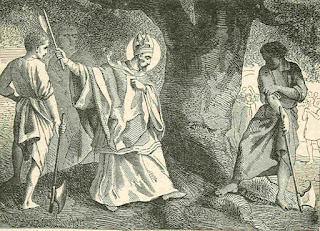The Vita Bonifatii auctore Willibaldi ("Life of Boniface by Willibald") tells us the story of Boniface and the oak tree dedicated to Donar. Here is the relevant excerpt:
...the saint attempted, ... , to fell a certain oak of extraordinary size, which is called, by an old name of the pagans, the Oak of Jupiter. And when in the strength of his steadfast heart he had cut the lower notch, there was present a great multitude of pagans, who in their souls were earnestly cursing the enemy of their gods. But when the fore side of the tree was notched only a little, suddenly the oak's vast bulk, driven by a blast from above, crashed to the ground, shivering its crown of branches as it fell; and, as if by the gracious compensation of the Most High, it was also burst into four parts, and four trunks of huge size, equal in length, were seen, unwrought by the brethren who stood by. At this sight the pagans who before had cursed now, on the contrary, believed, and blessed the Lord, and put away their former reviling.
The oak timber was used to build an oratory dedicated to St. Peter; the rest, as they say, is history.
At some point, however, this story became elaborated upon and embellished with long dialogues between Boniface and the pagan priests. Unbelievably, these stories evolved to Boniface convincing the newly-converted pagans that, rather than worship the oak, they should worship the fir, because the evergreen nature represents everlasting life, because it points upward to heaven, and because it is the wood of peace (too soft for weapons). This has led some to say that Boniface invented the Christmas Tree.
American author and clergyman Henry van Dyke wrote "The First Christmas Tree" in 1897. This may have been the origin of the modern myth.
Willibald was an interesting character, and a prime example of how well-traveled a person could be in the 8th century. He managed to visit most of the known world in his lifetime. We'll follow his travels tomorrow.

No comments:
Post a Comment
Note: Only a member of this blog may post a comment.